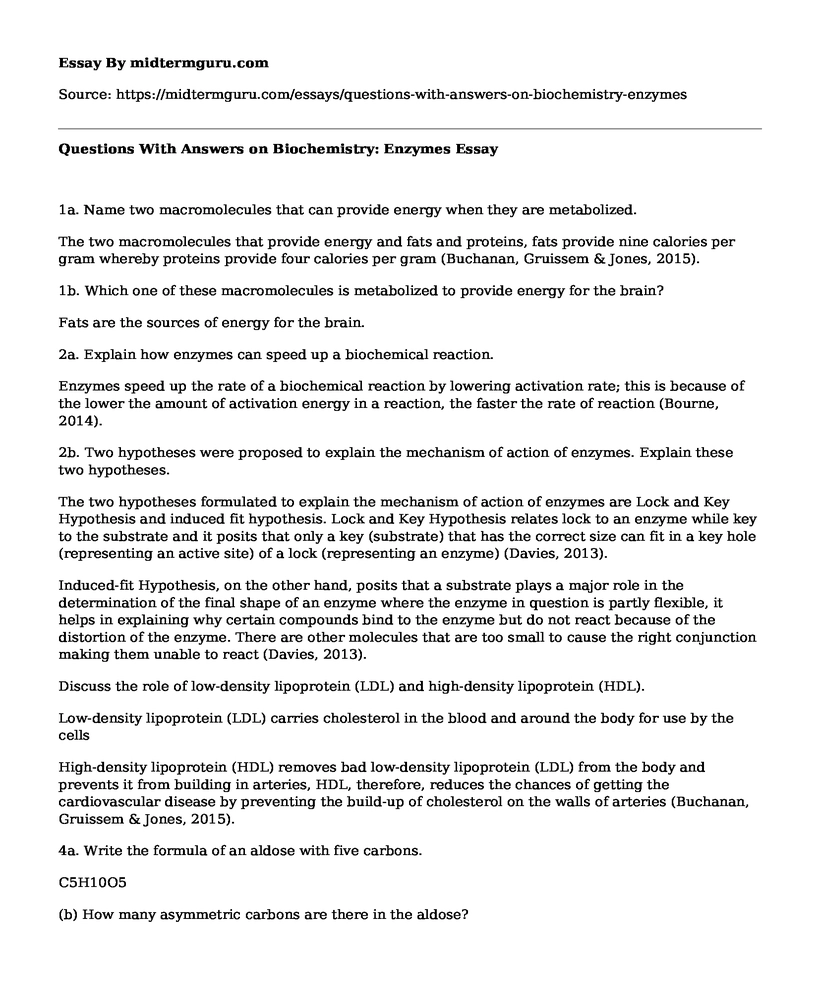1a. Name two macromolecules that can provide energy when they are metabolized.
The two macromolecules that provide energy and fats and proteins, fats provide nine calories per gram whereby proteins provide four calories per gram (Buchanan, Gruissem & Jones, 2015).
1b. Which one of these macromolecules is metabolized to provide energy for the brain?
Fats are the sources of energy for the brain.
2a. Explain how enzymes can speed up a biochemical reaction.
Enzymes speed up the rate of a biochemical reaction by lowering activation rate; this is because of the lower the amount of activation energy in a reaction, the faster the rate of reaction (Bourne, 2014).
2b. Two hypotheses were proposed to explain the mechanism of action of enzymes. Explain these two hypotheses.
The two hypotheses formulated to explain the mechanism of action of enzymes are Lock and Key Hypothesis and induced fit hypothesis. Lock and Key Hypothesis relates lock to an enzyme while key to the substrate and it posits that only a key (substrate) that has the correct size can fit in a key hole (representing an active site) of a lock (representing an enzyme) (Davies, 2013).
Induced-fit Hypothesis, on the other hand, posits that a substrate plays a major role in the determination of the final shape of an enzyme where the enzyme in question is partly flexible, it helps in explaining why certain compounds bind to the enzyme but do not react because of the distortion of the enzyme. There are other molecules that are too small to cause the right conjunction making them unable to react (Davies, 2013).
Discuss the role of low-density lipoprotein (LDL) and high-density lipoprotein (HDL).
Low-density lipoprotein (LDL) carries cholesterol in the blood and around the body for use by the cells
High-density lipoprotein (HDL) removes bad low-density lipoprotein (LDL) from the body and prevents it from building in arteries, HDL, therefore, reduces the chances of getting the cardiovascular disease by preventing the build-up of cholesterol on the walls of arteries (Buchanan, Gruissem & Jones, 2015).
4a. Write the formula of an aldose with five carbons.
C5H10O5
(b) How many asymmetric carbons are there in the aldose?
The number of asymmetric carbons in aldose is one (1).
(c) Give two possible Fisher projections representing optical isomers of the molecule (you can try and draw the two molecules in Microsoft word or submit a scan.
5 (a) What is a condensation reaction?
A condensation reaction is one which there is a combination of two molecules to form a larger molecule thereby producing a small molecule such as water, H20, as a byproduct (Bourne, 2014).
(b) Name the bonds when carbohydrates, proteins, and fats are formed from this type of reaction.
When proteins are formed, the bonds are peptide bonds.
When carbohydrates are formed, the bonds are glycosidic bonds.
When fats are formed, the bonds are ester bonds.
References
Bourne, G. H. (Ed.). (2014). The biochemistry and physiology of bone. Elsevier.
Buchanan, B. B., Gruissem, W., & Jones, R. L. (2015). Biochemistry and molecular biology of plants. John Wiley & Sons.
Davies, P. (Ed.). (2013). Plant hormones: physiology, biochemistry and molecular biology. Springer Science & Business Media.
Cite this page
Questions With Answers on Biochemistry: Enzymes. (2021, Jun 02). Retrieved from https://midtermguru.com/essays/questions-with-answers-on-biochemistry-enzymes
If you are the original author of this essay and no longer wish to have it published on the midtermguru.com website, please click below to request its removal:
- Essay on Reproductive Techniques and Technologies: Cohen and Mcmahan
- Classify Numbers by Use - Mathematics Essay Example
- Essay on Political Geography Subject: UN simulation representing Russian Simulation
- Analytical Chemist Applying for the Post of Laboratory Specialist for Antibiotics Discovery Project
- Cognitive Science: Exploring the Problem of Cognition - Paper Example
- Essay Sample on Mathematics an History as an Area of Knowledge
- Paper Example on Darwin and the Theory of Evolution by Natural Selection







